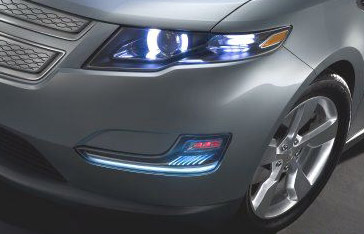GM Volt to Allow Smart Charging
In a conference call on Thursday, GM hinted that it will be implementing a system that will allow two-way communication between the Chevrolet Volt’s battery charger and electric utility companies.

One of the big potential problems with plug-in hybrid vehicles (cars that can be recharged by plugging them into a wall socket) is that if they’re ever widespread, and people plug them in all at the same time, it could overload the electricity grid.
But with the right equipment, plug-ins could actually be good for the grid. If the chargers had timers that put off charging until the wee hours of the night, the cars could make use of excess power-generating capacity on the grid. If the cars could communicate with each other, they could automatically stagger their charging, spreading out the load. And if they could communicate with utilities, they could charge when the utilities have extra power and stop charging if demand gets too high, helping to smooth out demand and prevent blackouts. There’s even a plan eventually to allow cars to deliver power back to the grid to help with peaks in electricity demand. Such smart charging could make it possible to incorporate more renewable energy, by helping to make up for the variable nature of wind and solar power.
Tony Posawatz, the vehicle line director for the Chevrolet Volt, confirmed that the Volt due out in November 2010 can be programmed by owners to charge at different times. The other stuff will require more complicated equipment. Without going into details, Posawatz said that GM’s OnStar system can allow for communications, making other equipment, such as smart electricity meters, unnecessary. At this point, it’s not clear what exactly the OnStar system will allow, or what will be available with the first version of the Volt, but Posawatz said that case studies are being conducted, and he suggested, by way of a rhetorical question, that the system could communicate with utilities. That could allow for much of the smart charging that could help stabilize the grid. The possibility of cars delivering power back to the grid, however, will have to wait, he said.
Keep Reading
Most Popular
Large language models can do jaw-dropping things. But nobody knows exactly why.
And that's a problem. Figuring it out is one of the biggest scientific puzzles of our time and a crucial step towards controlling more powerful future models.
The problem with plug-in hybrids? Their drivers.
Plug-in hybrids are often sold as a transition to EVs, but new data from Europe shows we’re still underestimating the emissions they produce.
Google DeepMind’s new generative model makes Super Mario–like games from scratch
Genie learns how to control games by watching hours and hours of video. It could help train next-gen robots too.
How scientists traced a mysterious covid case back to six toilets
When wastewater surveillance turns into a hunt for a single infected individual, the ethics get tricky.
Stay connected
Get the latest updates from
MIT Technology Review
Discover special offers, top stories, upcoming events, and more.